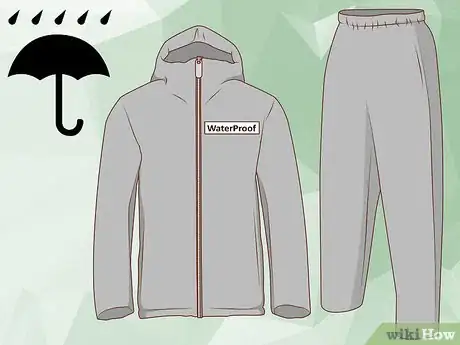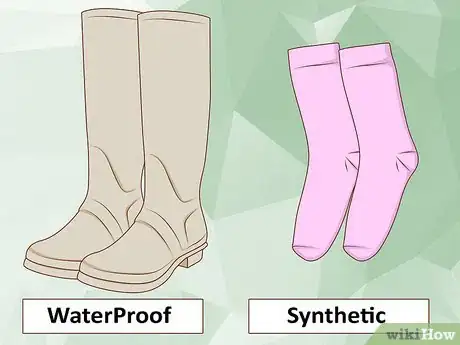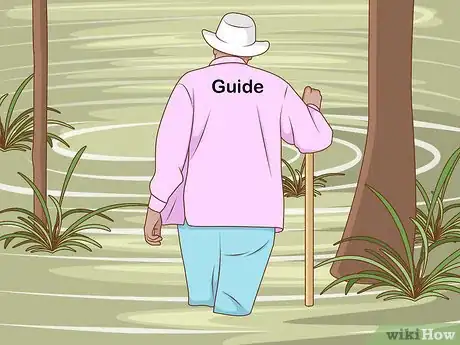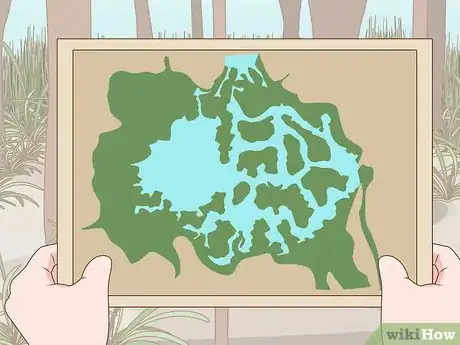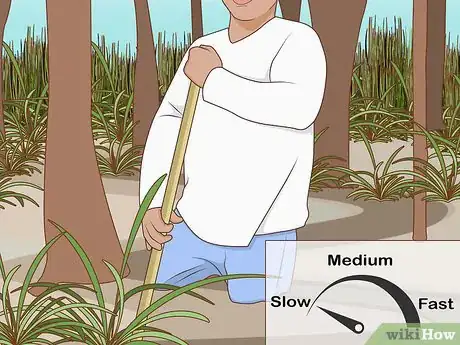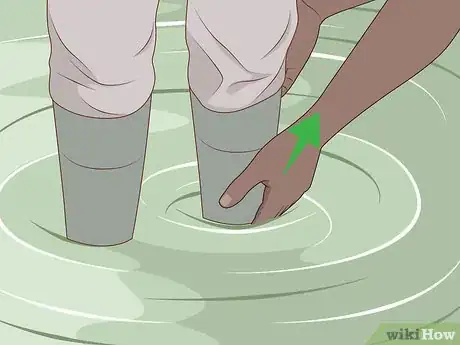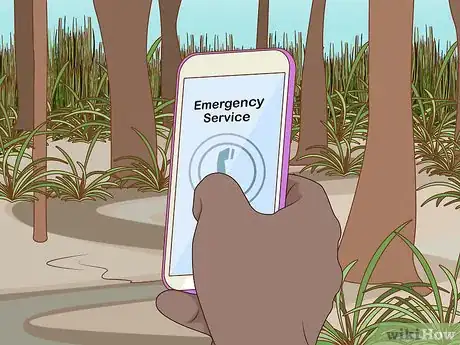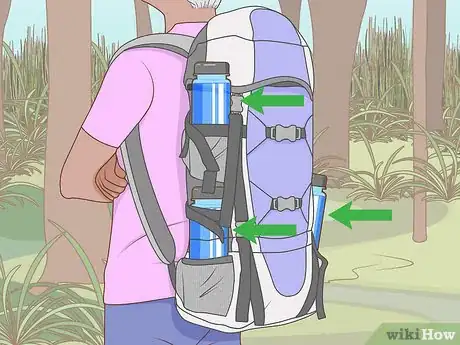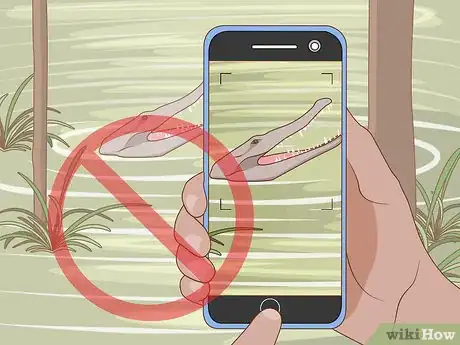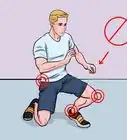This article was co-authored by wikiHow Staff. Our trained team of editors and researchers validate articles for accuracy and comprehensiveness. wikiHow's Content Management Team carefully monitors the work from our editorial staff to ensure that each article is backed by trusted research and meets our high quality standards.
This article has been viewed 163,258 times.
Learn more...
Walking through marsh, bog, and swamp areas can be challenging, but it's also a fun way to explore nature. If you go walking in a swamp, use waterproof equipment to keep yourself dry. Make sure to walk slowly and use a stick to test the depth of the swamp. Never go walking alone and be sure to bring a map. With some basic preparation and safety precautions, you can enjoy a fun walk in a swamp.
Steps
Dressing for a Swamp Walk
-
1Wear a cotton shirt and synthetic hiking pants or shorts. As you'll be wearing bulky gear over your clothes, opt for something light underneath. This will help you move through the swamp efficiently and prevent overheating. A simple cotton shirt and synthetic pants or shorts made for hiking are the best thing to wear under swamp gear.[1]
- You can purchase synthetic pants/shorts at a local outdoors shop or online. If you don't want to use synthetic material, opt for a light material like mesh or cotton pants.
- In addition to synthetic shorts or pants, synthetic underwear are also a good idea.
-
2Cover your clothing with waterproof gear. Before you go hiking in a swamp, pick up some waterproof gear at a local outdoors shop. You'll need a waterproof jacket and waterproof pants to cover your clothes. Not only will this keep you clothes clean, it protect you from potential bacteria that's found in dirt and swamp water.[2]
- It's not recommended to go hiking without waterproof gear. Some resorts may allow you to rent waterproof gear for swamp walks.
Advertisement -
3Wear gloves. It's important to protect your hands from water and dirt while hiking in a swamp. Wear a pair of synthetic, waterproof gloves at all times when hiking.[3]
- Gloves are vital for a swamp walk. Your hands will come into contact with a lot of dirt and debris and protection from bacteria is vital.
-
4Protect your feet with waterproof boots and heavy socks. A heavy pair of waterproof boots is a must for hiking. These should be worn with heavy wool or synthetic socks to keep your feet dry.[4]
- Like waterproof gear, waterproof boots are not optional for a hike. Your feet will be deep in swampy waters that can contain all kinds of bacteria. Protection is vital.
-
5Wear a hat or bandana. For any type of hiking, not just swamp hiking, it's important to wear a hat or bandana. A hat or bandana can help protect your face and scalp from the sun as you'll likely be hiking during peak hours of sunshine.[5]
-
1Take a guided tour if you have little experience in swamps. If you've never navigated a swamp walk before, make sure to take a guided tour along with a group of other hikers. A professional should guide you through your first swamp walk. Not only will they know basic safety rules, they'll know how to intervene in the event of an emergency.
- Resorts and camp grounds often provide guided tours. Check with someone at the information desk. You can also look for guided tours online.
-
2Follow a map. Under no circumstances should you go hiking without a map. Getting lost in a swamp can be very dangerous, so keep a map packed in a safe place. Make sure all members of your party have maps on hand in case you get separated.[6]
- In addition to a map, leave an itinerary outlining your hiking trial with someone who's staying behind. This way, if you and your party get lost, people will know the general area to search for you.
- Keep your map in your pocket or backpack when you're not using it. Always bring a backup map in case your map gets wet.
-
3Walk slowly. A swamp walk will not be fast and you will probably not cover a great deal of terrain. Instead, you should walk slowly and cover a smaller amount of ground. Take very slow steps so you can stay steady while navigating your swamp walk. If you start to feel wobbly, slow down your pace.[7]
- Remember, even if you don't cover a lot of ground, you can still enjoy your swamp walk by taking the scenery in great detail. Notice the sights, smells, and sounds around you as you move slowly through a swamp.
-
4Feel ahead with your walking stick before every step. You should always bring a walking stick on a swamp walk. Before every step, feel the area where you're going to place your foot with a walking stick. Avoid stepping in any areas where the ground feels soggy or where the water is very deep. Never take a step until you've used your walking stick to find a firm, shallow area in the swamp.[8]
-
5Deal with falls and getting stuck. If you or someone else gets stuck or falls in a swamp, assess the situation first. If the person is able to move their foot, ankle, or leg after a fall, gently help pry their foot out of the swamp and encourage them to keep walking. However, if the person is in a lot of pain and cannot move their leg, foot, or ankle, unlace the person's boot. Have them slowly remove their foot from the boot and lead them to a place to sit, such as a bench or dry patch of ground.
- It may take multiple people to move an injured person. This is why hiking in groups is important.
-
6Contact emergency services. If someone can't move, stop the hike and get help. Trails often have phones nearby where you can call for help. You can also have a non-injured person walk to the nearest ranger station. If someone has cellphone service, that person can call emergency services.
Taking Safety Precautions
-
1Make sure you have plenty of water. Never go on a swamp walk without packing a large bottle of water. Due to the extra effort of stepping through a swamp, you'll become very thirsty on your walk. Bring an extra large water bottle, preferably a gallon or more, and take sips every few minutes. If you become dehydrated, it's easy to become disoriented in the swamp. This can be very dangerous.[9]
- Make sure all members of your hiking party know to pack water as well.
-
2Wear sunscreen. Apply a generous layer of sunscreen to any parts of your body not covered by hiking gear. Reapply sunscreen if you get wet and every few hours. Check the package's directions to see how long the sunscreen lasts.[10]
-
3Do not hike alone. Never go hiking without a buddy. Even after taking a few guided tours through the swamp, it's always dangerous to hike through a swamp alone. In the event of an emergency, you'll need someone to call for help.[11]
-
4Leave wild animals alone. Swampy areas may have animals like alligators and poisonous snakes. For the most part, animals are unlikely to attack unprovoked. If you see a potentially dangerous animal, do not approach it or take picture. If you simply keep walking, the animal will probably leave you alone.[12]
- In the event you are bitten or otherwise harmed by an animal, have someone contact emergency services immediately.
Community Q&A
-
QuestionI have heard that there are parasites in some swamps that can get into your body through the pores. Is this true?
 Community AnswerYes, this is true. Don't walk in a swamp unless you are protected by the proper gear, such as waist high boots.
Community AnswerYes, this is true. Don't walk in a swamp unless you are protected by the proper gear, such as waist high boots. -
QuestionWhat if I get cut?
 Community AnswerClean the area and keep it dry.
Community AnswerClean the area and keep it dry. -
QuestionHow do I survive a lion attack?
 Community AnswerYou could try to climb a tree, yell, growl like a maniac and fight back. Hope that they get scared.
Community AnswerYou could try to climb a tree, yell, growl like a maniac and fight back. Hope that they get scared.
Warnings
- Assume that all swamp water is polluted. Avoid drinking it.⧼thumbs_response⧽
- If you sink into a bog, quicksand, or mire, don't struggle as you will sink deeper. lay back and swim out. Try not to lift one leg as the other will sink deeper and take off extra weight. avoid mudflats.⧼thumbs_response⧽
References
- ↑ https://www.backpacker.com/skills/swamp-gear-packing-checklist
- ↑ https://www.backpacker.com/skills/swamp-gear-packing-checklist
- ↑ https://www.backpacker.com/skills/swamp-gear-packing-checklist
- ↑ https://www.backpacker.com/skills/swamp-gear-packing-checklist
- ↑ https://www.backpacker.com/skills/swamp-gear-packing-checklist
- ↑ https://www.floridatrail.org/hiker-safety/
- ↑ https://bylandersea.com/2016/01/a-swamp-walk-in-the-everglades/
- ↑ https://www.floridatrail.org/hiker-safety/
- ↑ https://www.floridatrail.org/hiker-safety/

